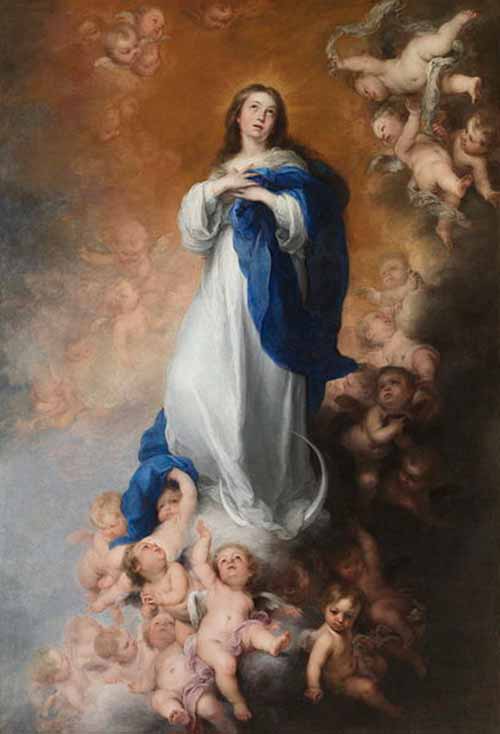
There is a very common misconception about Mary’s Immaculate Conception (Feast Day: December 8). Many people regularly think it is about a conception without sex – a virginal conception. It is not.
The feast day celebrates the conception of Mary in the womb of her mother nine months before Mary’s birth (feast day: September 8). The conception of Mary by her mother involved her parents having sex. In 1677, the Pope condemned people who taught that Mary was conceived with her mother remaining a virgin!
The Virginal Conception of Jesus (with which many people confuse the “Immaculate Conception of Mary”) is a distinct (and in this case, biblical, Matt 1:23; Luke 1:34) celebration – on March 25, nine months before Jesus’ birthday (December 25).
The Immaculate Conception of Mary is the belief that although the rest of us are conceived with Original Sin, God preserved Mary from this – she was conceived without Original Sin. Furthermore it is not a biological statement, as Mary’s virginal conception of Jesus entails.
The belief in the Immaculate Conception of Mary goes with a belief that she was sinless her whole life.
Justin Martyr and Irenaeus regarded Mary as the “new Eve”. The feast of Mary’s conception (December 8 ) traces to at least the seventh century. Bernard, Albert, Bonaventure, and Aquinas were either against it or very hesitant. Generally Franciscans were for it and Dominicans against it. The history turned in the fifteenth century, from when it began to gain strong grounds. In 1854 it was defined as a dogma in the Roman Catholic Church.
Mary was conceived in the normal manner by her parents having sex.
The Roman Catholic doctrine of the Immaculate Conception of Mary is founded on a particular concept of Original Sin. This understanding, developed by St Augustine, states (to keep it simple) that all humans, from the moment of our conception, carry the guilt of Adam and Eve’s sin. The Immaculate Conception is the claim that, from the moment of her (normal) conception, Mary was saved from this Original Sin.
Eastern Orthodoxy does not hold to Augustine’s model of Original Sin. Again to keep it simple, Eastern Orthodox hold that we experience the consequences of Adam and Eve’s Original Sin, but we do not carry the guilt. We are only, in that view, guilty of our own sins. Hence, the question of Mary’s immaculate conception does not arise if you do not hold to the Roman Catholic understanding of Original Sin. Old Catholics and Anglicans, then, are free (individually) to accept or reject the Immaculate Conception – it is not a position binding on them either way.
The extremely sad thing is, that for many people, “sin” and “sex” are understood as synonyms. [That is often the impression (read: “obsession”) that the Anglican Church also gives.] “Living in sin” is understood to be about sex – not about cheating on your tax returns, gossiping, or not recycling. So when people hear that Mary was “conceived without sin” – it is sadly unsurprising that they understand this to mean “without sex”.
In Orthodoxy, we are all conceived with the image of God. In some sense, then, Orthodoxy does not affirm the particular immaculate conception of Mary because, in a manner, we are all so conceived. Orthodoxy, then, tends to see sin as an illness (a therapeutic model with the church as a hospital for sinners). The West tends to see sin as moral failure (with a juridical model of sin – and often an angry God needing satisfaction and assuaging).
Contemporary Protestants often fear (when they correctly understand the Western teaching) that the Immaculate Conception bypasses Christ’s redemption. It specifically does not – Mary’s sinlessness is due to Christ’s salvation.
Contemporary Protestants are often revisionists, without a historical appreciation of their own founders. In 1544, Martin Luther said, ‘God has formed the soul and body of the Virgin Mary full of the Holy Spirit, so that she is without all sins, for she has conceived and borne the Lord Jesus.’ And: “All seed except Mary was vitiated [by original sin].”
In fact, most contemporary Protestants would mistake the teachings of the Reformers about Mary as being that of Roman Catholics. Calvin, Luther, Zwingli, and Wesley all accepted the perpetual virginity of Mary. The Book of Common Prayer and (binding) contemporary Anglican revisions call Mary “The Blessed Virgin Mary” – referring to her as a virgin throughout her life. [Not to mention defining Anne, of whom there is no mention in the Bible, to be the mother of the Blessed Virgin Mary].
Anglicans celebrate two conceptions: that of Christ (March 25) and that of Mary (December 8 ). Here is the Church of England collect for the feast of The Conception of the Blessed Virgin Mary:
Almighty and everlasting God,
who stooped to raise fallen humanity
through the child-bearing of blessed Mary:
grant that we, who have seen your glory
revealed in our human nature
and your love made perfect in our weakness,
may daily be renewed in your image
and conformed to the pattern of your Son
Jesus Christ our Lord,
who is alive and reigns with you,
in the unity of the Holy Spirit,
one God, now and for ever.
In January 2018, Rep. Matt Gaetz (R- Fla.) said the timing around missing text messages between the FBI’s Peter Strzok and Lisa Page could be considered “the greatest coincidence since the Immaculate Conception.” His is a good example of misunderstanding the term. CNN anchor Chris Cuomo (who attended Queens’ Immaculate Conception School) had to explain what the Immaculate Conception refers to – thereby nullifying the analogy.


